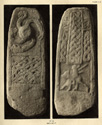 Glasgow, in common with most other Scottish burghs, consisted of a single parish until after the Reformation. Glasgow parish extended south to the Clyde and west to the Kelvin where it faced Govan parish across both of the rivers. Other medieval parishes were to be found at Rutherglen and Cathcart, but these were until modern times separate communities.
Glasgow, in common with most other Scottish burghs, consisted of a single parish until after the Reformation. Glasgow parish extended south to the Clyde and west to the Kelvin where it faced Govan parish across both of the rivers. Other medieval parishes were to be found at Rutherglen and Cathcart, but these were until modern times separate communities.
 The Reformation coincided with a great increase in the population of Glasgow, which led to the subdivision of the parish into three parishes. These divisions were reflected in the internal arrangements of the Cathedral. The choir became the place of worship for the High Church, from 1595 the Barony congregation used the crypt which became known as the Laigh Kirk, and the nave was walled off in 1647 to create a third space for the congregation of the Outer High Kirk. This remodelling helped to ensure the survival of the cathedral when it was under threat from radicals who wished to pull it down.
The Reformation coincided with a great increase in the population of Glasgow, which led to the subdivision of the parish into three parishes. These divisions were reflected in the internal arrangements of the Cathedral. The choir became the place of worship for the High Church, from 1595 the Barony congregation used the crypt which became known as the Laigh Kirk, and the nave was walled off in 1647 to create a third space for the congregation of the Outer High Kirk. This remodelling helped to ensure the survival of the cathedral when it was under threat from radicals who wished to pull it down.
 The experience of the surrounding parishes was perhaps more typical of developments elsewhere in Scotland. At Govan, Cathcart and Rutherglen the old church was extensively remodelled, old fittings were stripped out and the orientation of interior arrangements was altered. Eventually these churches were replaced, usually on or adjacent to the original location. This provided a strong sense of continuity for the community, particularly with respect to use of the cemetery.
The experience of the surrounding parishes was perhaps more typical of developments elsewhere in Scotland. At Govan, Cathcart and Rutherglen the old church was extensively remodelled, old fittings were stripped out and the orientation of interior arrangements was altered. Eventually these churches were replaced, usually on or adjacent to the original location. This provided a strong sense of continuity for the community, particularly with respect to use of the cemetery.
 Some of the other churches within the burgh were given new uses following the Reformation, while others disappeared. The Blackfriars church was given to the University as a chapel. The collegiate church of St Mary and St Anne became a kirk on the Trongate and its spire still survives. The church dedicated to Kentigern's mother, St Thenew, stood outside the burgh, but it was nevertheless retained, although it did undergo a name and gender change to St Enoch. The chapel dedicated to St Ninian in the Gorbals survived to modern times, although it ended its days as a pub in the 19th century. After the Reformation both the Franciscan church and the religious house at Polmadie disappeared.
Some of the other churches within the burgh were given new uses following the Reformation, while others disappeared. The Blackfriars church was given to the University as a chapel. The collegiate church of St Mary and St Anne became a kirk on the Trongate and its spire still survives. The church dedicated to Kentigern's mother, St Thenew, stood outside the burgh, but it was nevertheless retained, although it did undergo a name and gender change to St Enoch. The chapel dedicated to St Ninian in the Gorbals survived to modern times, although it ended its days as a pub in the 19th century. After the Reformation both the Franciscan church and the religious house at Polmadie disappeared.